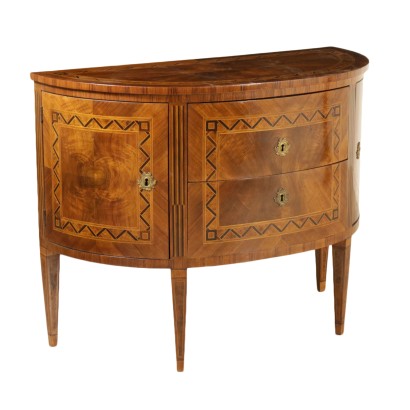Neoclassical Demilune Cupboard Italy Last Quarter of 1700
Features
Style: Neo-Classical (1765-1790)
Age: 18th Century / 1701 - 1800
Year: Ultimo quarto '700
Origin: Piemonte, Italy
Material: Walnut Feather Banded , Maple Burl , Elm Burl
Description
An elegant demilune cupboard, two doors and two drawers. Uprights with inlays and pyramidal feet. Cathedral walnut veneered reserves with inlaid Greek frets in different species. Maple, walnut and rosewood. Manufactured in Italy, last quarter of the 18th century.
Product Condition:
Good condition. Wear consistent with age and use. Any damage or loss is displayed as completely as possible in the pictures.
Dimensions (cm):
Height: 88
Width: 114,5
Depth: 52,5
Additional Information
Style: Neo-Classical (1765-1790)
This historical period includes a first phase that can be properly defined as the Louis XVI style.nOnly at a later time, with the maturation of archaeological fashions, was a new vision of furnishing civilization formulated and codified, now fully attributable to the Neoclassical Style.
In fact, both trends coexisted in unison until the last years of the eighteenth century.
nIn the field of cabinet making, the Directoire, Retour d'Egypte, Consular and Empire styles also fall within the neoclassical era.
nFind out more about Neoclassicism with the insights from our blog...
n





























